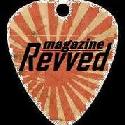
(click on picture to open file)
By: Michael D. Vogel
© Aprl 14, 1997. Michael D. Vogel. All Rights Reserved.
Published in:
The Album Network magazine – October 25, 1996
From seemingly out of nowhere, Seattle, WA punk/popsters, The Presidents Of The United States Of America (now that’s more than a mouthful) seem poised to once again capture the imaginations of America’s youth. Although no bet is entirely safe, in this instance, the best way to endear one’s self to the mainstream is to completely cut across it; to turn one’s back to the establishment and create your own musical vein.
That is exactly what The Presidents have done. Fresh from their 1995 Grammy nomination for “Best Alternative Music Performance,” and a certified double platinum debut release, the (other) boys from Seattle are ready for another term, with their sophomore release II; after all, this is an election year!
For this article, I got Two-String Basitar (a guitar with two bass strings)/singer Chris Ballew on the phone for a little chat.
The band has been covered by such a wide variety of magazines that you guys could be considered the media’s darlings. Does all the attention sometimes become overwhelming?
Chris Ballew: “When I was younger, I spent a great deal of time playing (music) down in the subway. Playing for such a diverse group of people gave me a good indication of what appealed to people. I was looking for some sort of physical reaction to determine whether my music was really being enjoyed. When I began to see a positive reaction, I knew I had achieved a certain level of success.
“As far as being on the cover of a magazine, I see that more as a screwed sense of reality. It’s not real in terms of who you are, how you feel, or the way you conduct your life. It’s very superficial and detached. The scene is set and the shots are already laid out. You take the pictures with the photographer and then it appears on the cover of the magazine. Sure, the exposure is great, but there are other things to do.
“In raw, basic terms, I look at it as simple advertising for the band. All the coverage is flattering and it definitely helps for recognition and the marketing of the albums, but I don’t get to the point where I change my frame of mind as an artist. At times, it seems as if I’m looking at someone else.”
After selling over 2,000,000 copies of your debut album, what’s next for The Presidents?
CB: “For me, the key to writing a good song is the music. I never compromised my songwriting toward the goal of popularity if I didn’t feel the song was good enough to be performed live. Unfortunately, a lot of people tend to discount something that is popular and fun, as not being worthwhile. Somewhere along the way, somebody took the roll out of rock & roll and it just became rock. If we are able to hold our own in the marketplace of incredibly meaningful rock, then that is the ultimate in musical statements. I just don’t think rock has to be socially conscious to be successful.”
How long does it take to write material in this stream of consciousness method?
“I didn’t really write songs for just the two records. Some of the material from the first album is from 1987 and some of the new album is from 1985, like ‘Little Indian Princess,’ which was sold on a demo tape at some of our early shows. As far as our live shows are concerned, we have begun to track through the back catalogue to incorporate some of our older material into the set. In all, the music just comes to me from all over the place. It develops somewhat of a life on its own; a song is done when it feels and sounds ripe and is ready to go. It could be a day, a week, month or even several years.
”The success we have seen as a band recently has inspired me to be more creative and really challenge myself to grow as an artist and songwriter. It really comes down to a 24-hour thing. I have tape recorders all over my house because I never know when creative inspirations are going to come to me. Every once in a while, I review what was recorded and if it catches my ear of cultivates the creative juices, I’ll develop it. I had this idea about writing a song about volcanoes; they explode with raw force and power – that’s rock & roll imagery at its finest!”
What kind of goals have you guys set as a band and what are the overall expectations of the new album?
“We really don’t have any. In a creative way, we kept the expectations low. We strive to do the best effort that we can. We do the interviews and the photo shoots, as well as the radio promotions. But from there, it’s really in the hands of the radio listener. If they appreciate our music then they’ll buy our albums. I never would have predicted that our first record would have done as well as it did.
”For the most part, this is all hindsight because these were never issues when we recorded the first album. I’d become a creative cripple if I tried to think in exclusive terms of what’s going to sell records. In my opinion, that is the first step on the path of making extremely mediocre music. This is a very personal art, an extension of one’s self. For the most part, I’m trying to be as creative as possible so that I don’t become bored with the scenarios of everyday life.
“As far as expectations from the label, we went into the studio and recorded the best album we could. My basic philosophy is that if you reach one person and it helps rock their world, then it’s all worthwhile.”
What kind of evolution will we be seeing in the musical styling of The Presidents?
“After this record, we’re ready for a slight style deviation. We have already begun thinking about adding an acoustic section to the middle of the set when we got out on tour again. The nuances get pummeled when we perform live. It’s really more about rhythm and less about the big tone taking over. BY doing so, we create more space in the music and ultimately provide a great contrast within our live shows by adding a five or six song acoustic set in the middle of the show – similar to a singing-around-a-campfire. I could see The Presidents taking that kind of direction.
”We have become a rock band because we play these huge shows, like Mt. Rushmore, as well as tours in Japan, Australia and Europe. My goal is to transcend this. I like the tension that is created when rock music is performed acoustically; that is really the sound I’m aiming for. Imagine, for example, if ‘Walk This Way’ was performed with acoustic guitars. That would create an interesting sound. Not your typical acoustic guitar, but a slightly overdriven guitar sound with a drum set and a modest little tone to carry the music. That kind of musical feel, like a campfire sing-along, would create tension for this anthemic arena rock song.”
Have you ever used an existing song or arrangement as a model for other material?
“I used to think that every song needs to have its own personality, but I don’t feel that way anymore. I don’t like the pre-packaged, homogenous music that is form-fitted to certain musical genres. As a result, I am not really driven to push the arrangements of the songs too hard. My main interest lies in achieving interesting tones and good lyrical content. For the most part, I leave that up to Dave and Jason. We’re not looking to rearrange how a rock song is created and performed; there are limits and restrictions within any given format. I like limitations; they cause you to use all your resources to be as creative as possible. The two-string bass and three-string guitars are good examples of these limitations that have provided for positive results.”
Coming off a constant touring schedule, when did you find time to write new material?
“I write all the time when I’m on the road. I never know when a creative idea is going to hit me, so I always bring an acoustic guitar, small keyboards and a tape deck. I go through my whole library of songs, fine tuning the older ones and writing new ones. So, every song is in a different state of construction all the time.
”If we start jamming to something in an aircheck, and we are all into it, then it’ll be a song that we spend further time developing. It’s a real natural kind of thing. We just let the cream rise to the top and never second-guess the effort that we put into it. If the song has merit, then it will rear its head and make some sort of impact on the fans.
“I have a bunch of songs that I have written myself. The sound is completely different from that of The Presidents. I represent the entire band on an 8-track recorder. Dave also has other songs that aren’t part of The Presidents’ repertoire. His musical approach is more revo0lving around straight-forward rock, with a Buddy Holly style.”
You guys produced this record, why?
“We knew what we wanted. We don’t want our ideas clouded by an outside person’s interpretation of what our band was supposed to be about. We’ve tried to work with other producers before and it has worked to some degree, but the situations always tend to be tense, ultimately ending up in a deadlock between them and us. Producing our own album created quiet an interesting situation for us for us because on one hand, it requires a lot of critical listening and not letting it interfere with the creative process. The only outside source was our sound engineer, Craig Montgomery, who is a veteran of the business, having worked with bands like Nirvana. He has a real understanding of our sound, helping to translate that during our live shows, as well as on our studio albums.”
What kind of album did you set out to make?
“We had the material for the album already finished. A lot of the songs we have been playing live for quite a while. The idea was to go into the studio, record the songs and then augment them with different sounds.
”When we originally went into the studio, back in January, we did too much thinking and not enough drinking. Working under those type of conditions can be very constricting and really promote atrophy of the creative spirit. As a result, we ended up with an uptight sound that we just weren’t happy with. Ultimately, we scrapped most of the project, keeping only a few basic tracks and some vocals.
“The initial recordings were done at The Wilson sisters’ studio, Bad Animals. The bulk of the recording was done in about 20 days at the end of August. Most of the album was (ultimately) recorded at Studio Litho in Seattle, which is Stone Gossard’s studio for Pearl Jam.
“In a nutshell, we look at our music as a sonic representation of three guys having fun and then jettisoning it out into the world. On a professional level, I think the ultimate compliment for The Presidents would be that our music inspired someone else to go out and start a band.”
What’s the story behind the first single, “Mach 5?”
“Think back to when you were a small child and the thrill and exhilaration you experienced when smashing little matchbox cars. I took the basic experience and emotion and incorporated it into a rock song. Sure, there are some ‘Speed Racer’ tie-ins, but overall there are no hidden meanings in the song. Some people hear rockets and others hear cars. In its simplest definition though, the song is about the joy of smashing toy cars with rocks and hammers.”
Where do you draw the ideas for each song?
“I have gotten pretty good at exercising my imagination and keeping it nimble. A lot of what I think of doesn’t make sense, but that’s the fun of being creative – it doesn’t have to be coherent. I draw most of the ideas from childhood experiences. Some of the characters in the songs, and the style of the lyrics, came from the time my brother and I would make up songs while we were playing with our Lego’s.”
“I was trying to write songs for years that weren’t very personal, somewhat strange and removed from my own experiences. Then the realization hit me – my life experiences are my vocabulary for the songs. I started mining that without regard for whether the lyrics made sense because somehow they would make sense. Paul McCartney wanted to remove a line from ‘Hey Jude,’ but only after insistence from John Lennon was the line left in. The lesson learned is that if you can get outside of your own expectations, as well as living with your own mistakes, you tend to realize that things are better than what you originally thought in the first place.
“I try to write material that I am familiar with. I will take something I am fairly familiar with and then take it to the fantasy level. For example, ‘Dune Buggy’ starts out with the nut of the song describing a childhood memory of finding spiders dried up inside a toy police car in a heating duct. I then took it one step further, into a different world, where spiders drive dune buggies. It’s kind of like starting with a kernel of reality and then taking poetic license to manipulate it.
“Ultimately, the song doesn’t have to be about reality. It’s just an opportunity to be weird and crazy and surreal and not make any sense whatsoever.”
What are some of the things, then, that you do take seriously?
“I look at it more like reveling in certain feelings and subject matters. It is from this point that I take a little poetic license and dress it up in a somewhat surreal way. It’s simply a matter of playing with the material and not trying to deconstruct the feeling or sentiment to the point of parody. It all comes back to the point of having fun. The music paint’s a mental image, it’s meant to promote a festive atmosphere – plain and simple!”
Your live shows have a lot of energy. Have you ever thought about recording some material live?
“We are planning to release 12 live B-side songs for this record. Some songs are renditions from the first and second albums, while others are new material that we have not yet recorded. In addition, there will also be a promotional CD with five or six songs that should be included with the new album. Unfortunately, this is only promotional and will be included with the new record through Christmas.
”As a project by itself though, I would love to do some sort of a lie album. Whether it was an MTV ‘Unplugged’ show or one of our concerts, this would help bring the band into the living rooms of those that have never experienced one of our shows.”
What’s the deal with the hidden track on the album?
“It’s a song I made up with a bunch of friends back in 1986. My buddy was relaying this story about a basketball dream he had while I was at a typewriter typing out a few bits. After whispering part of the story to my then six-year-old nephew Tony, he repeated it into a recorder. After putting it music, I had this little unexpected gem.”
In hindsight, have you found it to be a detriment being called The Presidents Of The United States Of America?
A name is just a name. It is simply something that is functional. It is not there to make some sort of profound statement. The point is really to bring people into our shows and turn them on to our music. What would it take for me to randomly purchase an album? – A band with a distinctive name. So, I guess we have accomplished that goal!” ^m^
Photograph credit: Lance Mercer
Origin:
Seattle, WA
Line-Up:
Dave Dederer – Three String GuitBass & Vocals
Chris Ballew – Vocals & Two-String Basitar
Jason Finn – No-String Drums & Vocals
About The Current CD:
II is the sophomore release from The Presidents. This album follows on the heals of their double platinum debut release in 1995.
Discography:
The Presidents Of The United States Of America: II – (Columbia, 1996)
The Presidents Of The United States Of America – (Columbia, 1995)
Produced By:
Chris Ballew, Dave Dederer & Jason Finn
Label:
Columbia
Website:
© Aprl 14, 1997. Michael D. Vogel. All Rights Reserved. This originally appeared on the Vogelism blog at https://www.vogelism.com authored by Michael D. Vogel. This article may be shared or reprinted as long as the entire copyright message, including the source location of this article, accompanies it.














 Welcome to Michael D. Vogel’s online portfolio. I am a Los Angeles-based music journalist/content creator, and self-professed music-fanatic/radio-aholic. With more than 20 years of experience in multiple facets of the music industry including; music programming/air talent for terrestrial and internet radio as well as record label artist promotion, I have a finger on the pulse of what's new and under the radar in the emerging music scene. Areas of specific expertise include, but not limited to: rock (heritage, mainstream, heavy metal/hard rock and alternative), pop and adult contemporary, as well as radio, pop culture, sports, exercise and politics. I am applying my passion for music as a freelance writer for the Examiner as National Music Examiner (Examiner.com) in addition to West Coast Editor for FreeGotham (FreeGotham.com). Find me at michael@vogelism.com.
Welcome to Michael D. Vogel’s online portfolio. I am a Los Angeles-based music journalist/content creator, and self-professed music-fanatic/radio-aholic. With more than 20 years of experience in multiple facets of the music industry including; music programming/air talent for terrestrial and internet radio as well as record label artist promotion, I have a finger on the pulse of what's new and under the radar in the emerging music scene. Areas of specific expertise include, but not limited to: rock (heritage, mainstream, heavy metal/hard rock and alternative), pop and adult contemporary, as well as radio, pop culture, sports, exercise and politics. I am applying my passion for music as a freelance writer for the Examiner as National Music Examiner (Examiner.com) in addition to West Coast Editor for FreeGotham (FreeGotham.com). Find me at michael@vogelism.com. 